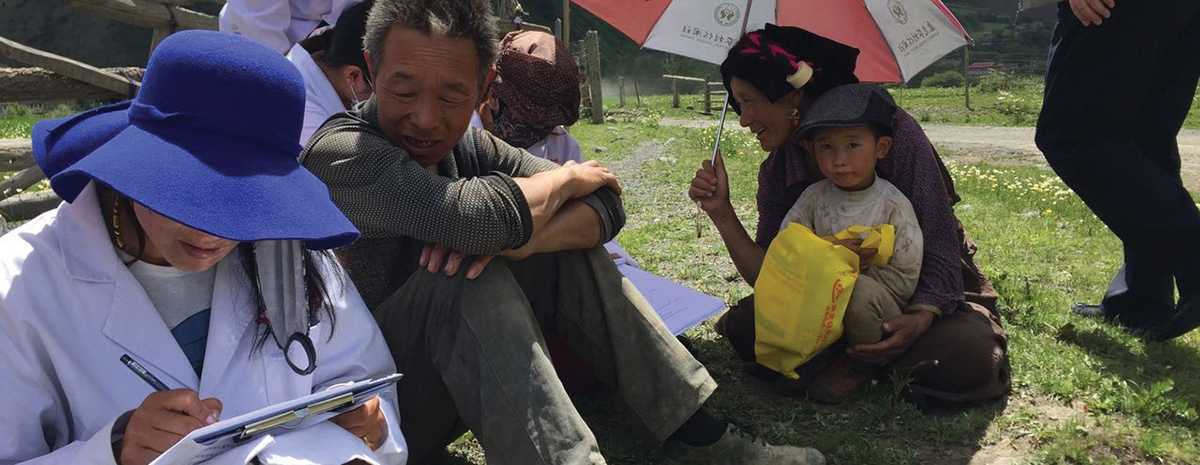
The Centers for Disease Control and Prevention (CDC) and the Chinese government have collaborated on public health priorities that affect China, the U.S., and the global community for more than 30 years. CDC focuses its China-based work on HIV/AIDS, emerging and re-emerging infectious diseases, immunizations, workforce development, influenza, noncommunicable diseases, laboratory quality and safety, and global health security. The China-CDC partnership is increasingly dedicated to supporting China’s role in the international public health community through dissemination of scientific information and support to other developing countries.

CDC STAFF
8 U.S. Assignees
39 Locally Employed

AT A GLANCE
Population: 1,374,620,000
Per capita income: $3,379
Life expectancy at birth: 76.3 yrs
Infant mortality rate: 5.9/1000 live births

TOP 10 CAUSES OF DEATH
- Cardiovascular Diseases
- Neoplasms
- Chronic Respiratory Diseases
- Diabetes/Urological/Blood/ Endocrine Diseases
- Transport Injuries
- Neurological Disorders
- Unintentional Injuries
- Diarrheal Diseases
- Cirrhosis
- Self-harm & Violence
Source: The 2015 national economic and social development statistical bulletin, National Bureau of Statistics of the People’s Republic of China
Source: GBD Compare: China, 2015
Stories
Impact on China
- In 2009-2010, measured the prevalence of latent TB infection of almost 70% among healthcare workers in a high- risk region.
- Influenza program supported launch of China’s first active surveillance for respiratory illness among pregnant women; enrolled >3000 pregnant women in first 2 project months.
- Following a population-based intervention to reduce dietary salt intake in Shandong Province during 2011-2016, participants’ 24-hour urinary sodium excretion (a measure of salt intake) decreased by 26% and their systolic and diastolic blood pressures also decreased significantly.
- 24 current and graduated CFETP residents have been deployed to West Africa in support of Ebola as well as yellow fever.
HIV/AIDS
The China-CDC collaboration on HIV/AIDS was launched in 2003 with the goal of controlling the spread of HIV from people already infected. China’s estimated HIV prevalence is low (less than 0.1%), but with an estimated 825,000 people living with HIV, the country has one of the larger infected and at-risk populations in the world. The collaboration emphasizes technical assistance to China in developing evidence-based national HIV/AIDS policy and guidelines. It also builds local capacity in surveillance, data utilization, counseling and testing, research, laboratory methods, interventions for hard-to-reach populations, and quality HIV treatment, care, and support. Activities are concentrated in five key provinces with high disease burdens and restricted economic resources. Particular attention is focused on key populations, such as men who have sex with men, and on engaging civil society.
Global Health Security
A health threat anywhere is a health threat everywhere, and nowhere is that more true than in China, America’s largest trade partner and a hub of global travel. CDC’s work in influenza, infectious diseases, immunization, risk communication, and emergency response all support the goals of global health security. The Ebola outbreak in West Africa in 2014 galvanized the US and China to collaborate together for the first time in an international health emergency outside of their borders. Since 2014, 24 of the Chinese public health experts who were deployed to Africa were graduates of or residents in the Chinese Field Epidemiology Training Program (CFETP). China has supported the establishment of the Africa CDC and contributes to additional work in Sierra Leone. Going forward, the US will work to continue to support China in a leadership role in global health security.
Field Epidemiology Training Program (FETP)
The Chinese Field Epidemiology Training Program (CFETP), a two-year program, strengthens disease surveillance, applied epidemiology, and response capacities through a rigorous curriculum and extensive field work experience that is designed to train China’s future public health leaders. 248 CFETP residents have graduated across the country and have conducted more than 2000 outbreak investigations as part of their training. In 2016, a new, one-year Western FETP was launched to increase epidemiologic capacity in the Western provinces of China.

Emerging and Re-emerging Infectious Diseases (EID)
US and China-CDC experts work together to help China identify and contain infectious disease outbreaks before they spread globally. Recent collaborations to support surveillance and operational research on foodborne-diarrheal infections, healthcare-associated infections, respiratory diseases, and viral hepatitis have increased awareness about antibiotic-resistant organisms, identified risk factors for disease transmission, and helped reduce under-reporting of infections. EID staff also work with China-CDC to help reduce the human disease burden due to rabies, brucellosis, and other zoonotic diseases. With approximately 1.2 million tuberculosis (TB) cases in 2014 (the third highest burden after India and Indonesia), the EID Program also supports projects to improve TB surveillance, strengthen infection control practices at healthcare facilities, and increase treatment completion rates among TB patients. The EID program assists China in strengthening the laboratory network system to rapidly detect emerging pathogens through implementing internationally-based quality control and assurance practices and through trainings on worker safety and risk reduction.
Influenza
For more than 20 years, US CDC has supported the Chinese national influenza laboratory to monitor seasonal and novel influenza viruses. Currently, in partnership with China-CDC, provincial CDCs, and academic institutions, the Influenza Program in China enhances efforts to detect, monitor, respond to, and control human seasonal, avian, and other novel influenza viruses with pandemic potential, such as H7N9, to reduce influenza-associated mortality and morbidity. Key activities supporting these goals include strengthening influenza surveillance; conducting research to estimate disease burden and vaccine effectiveness among populations at greatest risk (including young children, older adults, and pregnant women); promoting influenza vaccination; supporting outbreak investigations; and establishing pandemic influenza preparedness.
Immunization
CDC works with Chinese public health officials to eradicate, eliminate, or control vaccine-preventable diseases through immunization. A CDC expert assigned to the World Health Organization China office leads efforts to advise China on strengthening its immunization program and on enhancing evidence-based immunization recommendations and practices. Immunization goals include implementing the Polio Endgame Strategic Plan 2013-2018, eliminating measles, and accelerating control of hepatitis B. Additional efforts include strengthening
Risk Communication and Emergency Response
Capacity building is the primary goal for CDC’s collaborations with Chinese counterparts in both risk communication and emergency response. Since 2006, CDC has developed risk communication theory and training materials that have been adapted into guidelines, a handbook, and an online training module. More than 2,400 health professionals have received face-to-face training. CDC has also supported the Chinese health hotline in establishing a social media account to conduct fast, two-way health communication.
Noncommunicable Diseases (NCD)
An estimated 88% of total deaths each year in China are caused by NCDs and an additional 7% are caused by injury. In recognition of this significant public health burden, China and U.S. CDC have developed an innovative collaboration engaged in activities that include NCD management (cardiovascular diseases and diabetes) and NCD risk factors control (salt reduction, trans fatty acid control, tobacco control, and road traffic injuries), and human resource capacity building.
Related Links
Travel
General
Diseases
Hepatitis B
- Hepatitis B Information
- Progress in Hepatitis B Prevention Through Universal Infant Vaccination — China, 1997–2006
- Viral Hepatitis Populations – Asian & Pacific Islanders
Japanese Encepahlitis
- Page last reviewed: July 31, 2017
- Page last updated: July 31, 2017
- Content source:
Global Health
Notice: Linking to a non-federal site does not constitute an endorsement by HHS, CDC or any of its employees of the sponsors or the information and products presented on the site.



 ShareCompartir
ShareCompartir